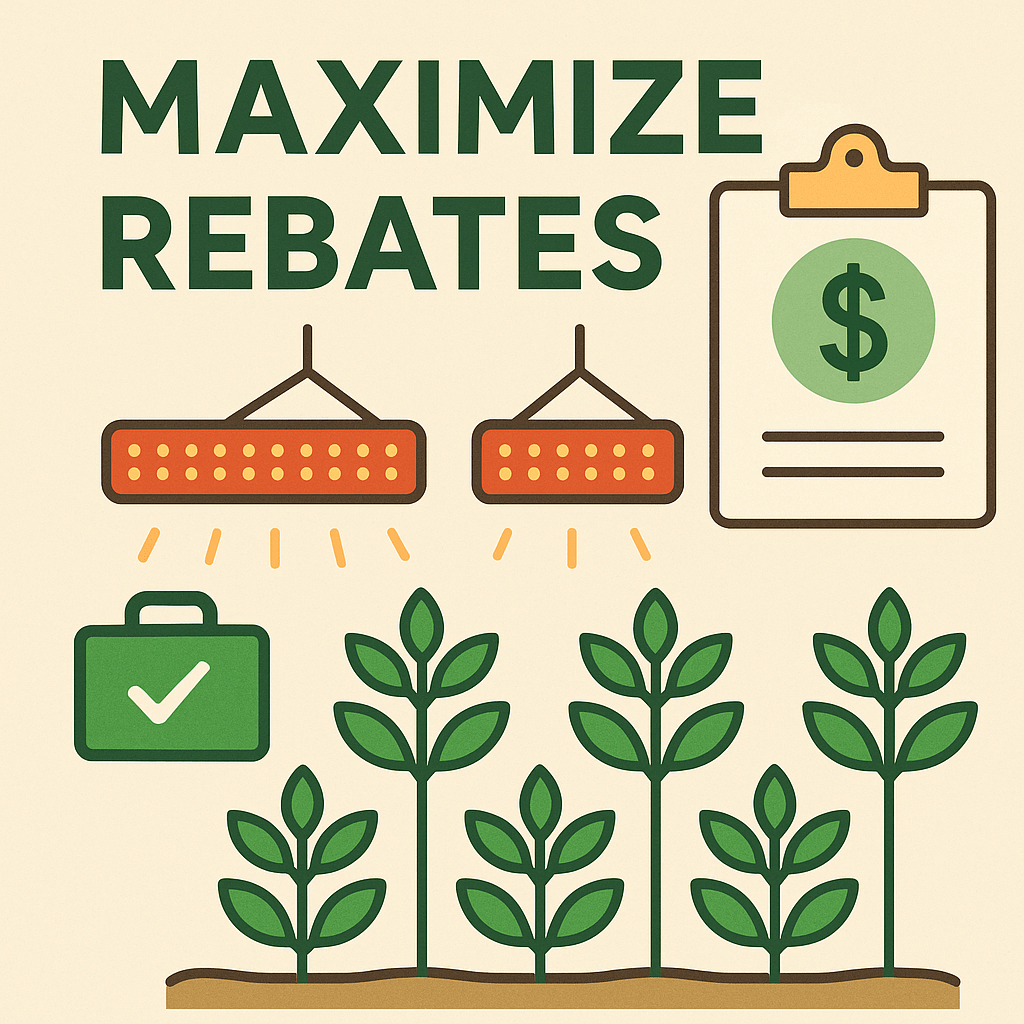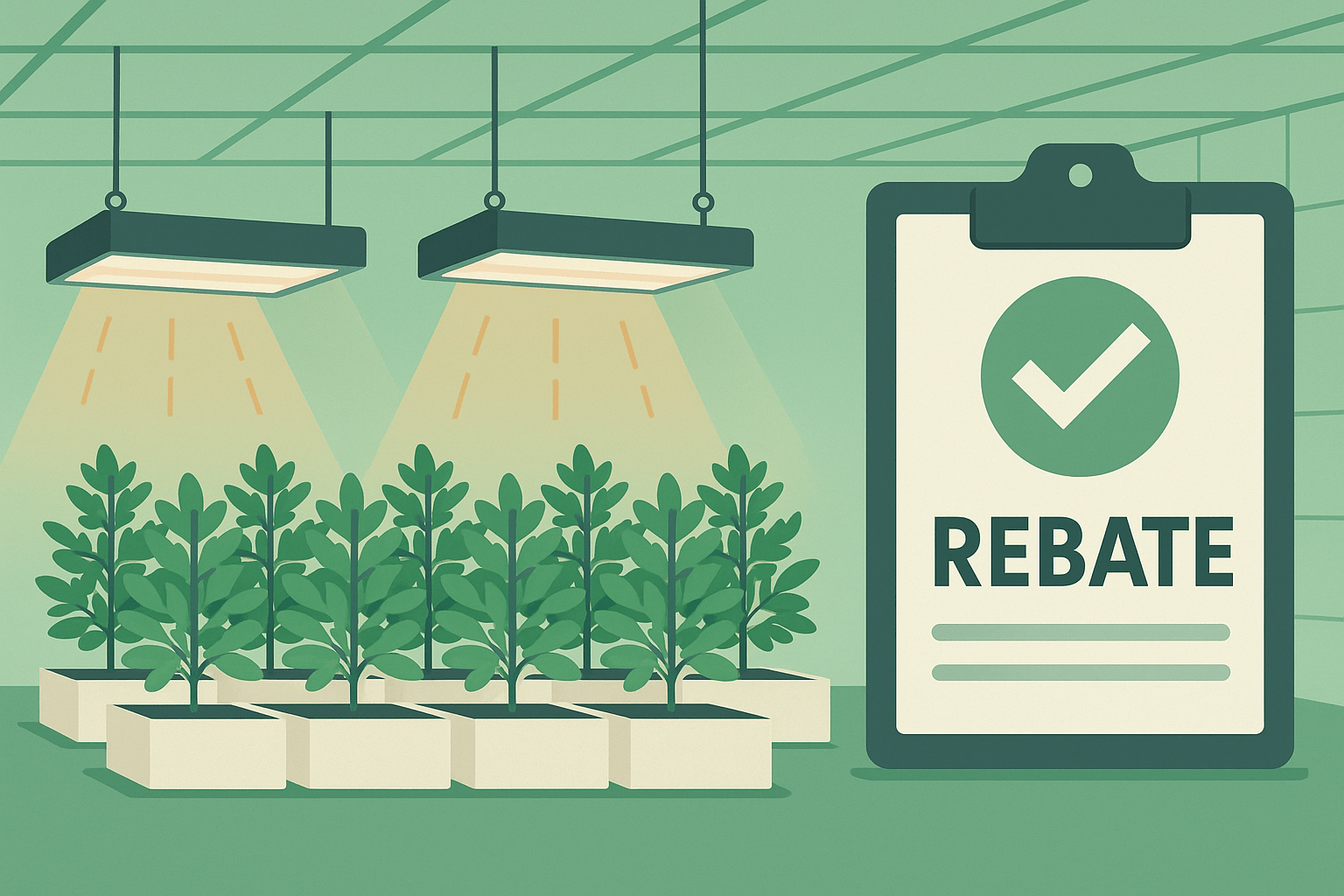It is crucial to involve LED Grow Lights Rebate Solutions early in your project. The final cost basis of your lights interacts with the structure of rebate programs in ways that are not obvious to the uninitiated. Consider, for example, under-canopy LED grow lights or overhead fixtures that are sometimes available in multiple footprints. Even before rebates are involved, there are many considerations for the grower.
When considering the types of LED grow lights to use, it’s essential to look at the spectrum of light produced. Different plants have varying light requirements, and choosing the right spectrum can significantly impact growth and yield. For example, blue light is crucial for vegetative growth, while red light supports flowering and fruiting phases. Many advanced LED grow lights now allow for spectrum adjustment, giving growers greater control over the growth conditions.
Understanding Light Coverage
Additionally, larger LED grow lights often feature more advanced cooling systems, which can help prevent overheating. This is crucial because excessive heat can reduce the lifespan of the lights and negatively affect plant health. Some high-quality models utilize passive or active cooling systems to maintain optimal operating temperatures, ensuring efficient operation.
Impact of Light Positioning
With under-canopy lights, proper positioning is equally crucial. They should be angled to ensure light reaches plants effectively, minimizing shadows and ensuring uniform light distribution. Some growers opt for adjustable mounting brackets to fine-tune light angles.
Light positioning can drastically affect plant growth. Hanging LED grow lights at the correct height is essential; too high may lead to insufficient light, while too low can cause light burn. Regularly adjusting the height based on plant growth stages can optimize light exposure. For instance, during the seedling stage, lights should be positioned closer to promote sturdy growth, while during flowering, they can be raised slightly to prevent burn.
Trends in LED Grow Light Technology
Another trend is the use of full-spectrum LEDs, which provide a balanced spectrum that mimics natural sunlight. These lights support all growth stages, making them a versatile choice for various crops. Growers increasingly favor these lights as they can reduce the need for multiple light types, simplifying setups and potentially lowering costs.
The LED grow light market is continuously evolving with innovations aimed at enhancing efficiency and reducing energy consumption. One significant trend is the integration of smart technology. Many modern LED grow lights can now be controlled via smartphone apps, allowing growers to adjust light schedules, intensity, and spectrum remotely. This capability not only enhances convenience but also ensures plants receive optimal light conditions at all times.
Environmental Considerations
Financial Aspects of LED Grow Lights
Consider conducting a cost-benefit analysis before making a purchase decision. This analysis should factor in installation costs, expected lifespan of the lights, and potential energy savings. For example, if a grower anticipates an energy bill reduction of 30% with LED adoption, it can significantly shorten the payback period for their investment.
Maintaining LED Grow Lights
Moreover, keeping an eye on the wiring and connections is essential. Any signs of wear or damage should be addressed immediately to prevent electrical shorts or failures. Implementing a routine check-up schedule can help catch potential issues before they escalate, ensuring uninterrupted growth cycles.
Case Studies on LED Grow Light Usage
Similarly, another research study showed that tomatoes grown under LED lights exhibited faster growth rates compared to those under traditional lighting. This highlights the potential of LED technology to boost not only yield but also crop quality.
Future of LED Grow Lights
Additionally, research into plant biology continues to unveil new insights into how different light spectrums affect various plant species. This knowledge will inform the development of tailored LED grow lights that can cater to specific crops, enhancing both growth and quality.
Community and Support Resources
Final Thoughts on LED Grow Lights
In conclusion, the right LED grow light can significantly influence your growing operation’s success. With careful consideration of factors such as light spectrum, positioning, and maintenance, you can maximize your investment. Remember, as you navigate the complexities of choosing and implementing LED grow lights, it’s essential to stay informed and be prepared to adapt to new technologies and insights. Embrace the potential of LED grow lights to enhance your cultivation efforts and optimize energy use.
Joining a community of growers can provide ongoing support and resources. Many online forums and social media groups focus on LED grow lights, where growers share their experiences, tips, and troubleshooting advice. Engaging with these communities can enhance your knowledge and help you stay updated on the latest trends and technologies.
The future of LED grow lights looks promising with ongoing advancements in technology. As more growers recognize the benefits of LEDs, we can expect increased competition in the market, leading to even more innovative and efficient products. Furthermore, the integration of AI (Artificial Intelligence) in the growing process will likely optimize environmental controls, improving overall efficiency and yield.
Examining real-world applications of LED grow lights can provide valuable insights. For example, a leading cannabis cultivation company switched to full-spectrum LED grow lights and reported a 20% increase in yield due to optimized light conditions. This case illustrates how LED technology can significantly enhance productivity when implemented thoughtfully.
Regular maintenance of LED grow lights is crucial to ensure consistent performance. Dust and debris can accumulate on light fixtures, reducing their efficiency over time. Periodically cleaning the lights, especially the lenses, can maximize light output and prolong their lifespan. It’s advisable to follow manufacturer guidelines for cleaning to avoid damaging any components.
While the initial investment in LED grow lights may be higher compared to traditional lighting, the long-term savings in energy costs often justify this expense. On average, LEDs consume up to 50% less energy than HID (High-Intensity Discharge) lamps, leading to significant savings over time. Additionally, many utility programs offer rebates for installing energy-efficient lighting, further enhancing the financial viability of LED adoption.
As sustainability becomes a more pressing issue, environmental considerations in choosing LED grow lights are gaining importance. Energy-efficient LED lights not only reduce energy costs but also minimize the carbon footprint of indoor farming operations. Additionally, many manufacturers are now prioritizing eco-friendly materials and processes in production, appealing to environmentally-conscious growers.
It’s important to understand the concept of light coverage when selecting LED grow lights. The coverage area directly affects how evenly light is distributed across your plants. If a light’s coverage area is too small, you may end up with uneven growth, where some plants receive more light than others. This can lead to inefficient growth and lower yields. To optimize your setup, consider using light meter tools to measure the PPFD (Photosynthetic Photon Flux Density) across your growing area and adjust accordingly.
Economics of Larger LED Grow Lights
Generally, a light with a larger footprint can be cheaper on a purchase-price basis. More light packed onto a single ballast means you’re paying for less electronics per unit area; you may be able to cover the same area for less purchase cost by choosing bigger lights.
Ergonomics and Operational Efficiency
Depending on your setup, under-canopy grow lights need to be moved out of the way each harvest for cleaning. An eight-foot light is a little bit more than half as much work as moving two four-foot lights. The more tedious the job is, the more likely a crew-member is to start wrestling the lights, potentially leading to damage and yield loss or downtime.
If you have to take out your under-canopy every cycle, then each individual connection between lights needs to be properly clicked-in every cycle to prevent water from getting in. I hope the lights you buy have locking waterproof connectors! Eight-foot lights provide half as many of these points of failure for the same coverage, and half as many chances for you or your crew to miss a click.
Insights from Commercial Growers
We talk to operators of large commercial cultivation sites a lot, and over the timeline of an entire rebate process they have the opportunity to tell us a lot about their operations and challenges. Picking the right light is a big deal, and if you’re reading this, I congratulate you on taking your work seriously.

Regional Differences in Grow Lights Rebates
The most economical LED grow light to choose may be different depending on your geography and utility company. We’ll be happy to take a close look at your situation!
For example, consider a facility in CA vs one in MI. In CA, depending on your power company, there is likely to be a rebate program that pays out on a per-fixture basis. (Your payout may depend on your climate zone, please get in touch with us for details.) In this per-fixture case, you might be better served by opting for the smallest possible light to maximize the efficiency incentive you are eligible for. See PG&E Rebates & Incentives for details.
Contrast this with facilities in Consumers Energy’s service area in MI. The incentive there is calculated per watt installed. In that case, bigger LED grow lights may again be more economical. See Consumers Energy Business Rebates for current programs.
Field-Adjustable Wattage Benefits
If your chosen lighting manufacturer features field-adjustable wattage, you have remarkable flexibility to shape your facility’s electrical demand. These additional wattage modes could have implications for your incentive eligibility — it depends on the specific model and the program in question.
Program Metrics and Compliance
Under some programs, using the least wattage that gives acceptable coverage is the best move, which is what you might expect. Yet, this is not always the case!
Other programs calculate based on the PPFD, or (total) PPF, or PPE, based on a baseline from the rebate program implementer or statutorily defined values as found in California Title 24 Energy Code.
Under these programs you may actually qualify for more grow lights rebates by putting out as much efficient light as you can from the LEDs, at the highest wattage. This may be counter-intuitive. However, consider this: the increase in yield from making existing conditioned-square-footage more productive is generally less incremental load on the grid than building out additional space or another site. You may find this also increases your margins, depending on the crop.
Verification and Compliance Risks
Energy companies, in almost all cases, reserve the right to perform normalized metered energy consumption to see if you’re truly operating as you claimed! You may receive a prorated rebate or even be asked to return funds if your application was inaccurate, and this can become a lethal cashflow situation.
In conclusion, it can be a bit complicated. We want you to succeed, so please contact us. Remember, investing in the right led grow light can make a significant difference in your grow operation.
In conclusion, it can be a bit complicated. We want you to succeed, so please contact us.

